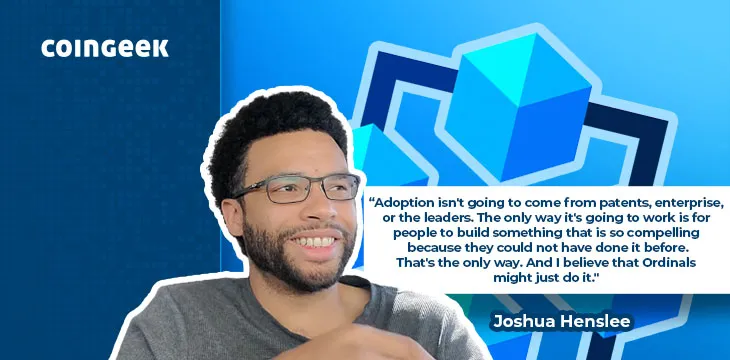|
Getting your Trinity Audio player ready...
|
1Sat Ordinals on Bitcoin SV (BSV) have “got a pretty good shot” at creating a compelling and popular use case for BSV, says developer and Bitcoin commentator Joshua Henslee. In a video released this week, Henslee calls for more innovation and creativity in the BSV world and says Ordinals have the potential to gain much-needed attention by appealing to the user community instead of outsiders.
Yes, we do need speculation and liquidity to make BSV work, Henslee says. He doesn’t hold back with his harsh criticism of some of the attitudes and practices in BSV’s history, particularly the tendency to develop and promote new token protocols and to disagree over whom to target with BSV’s marketing efforts.
What are Ordinals?
Ordinals is a token protocol that “inscribes” additional data onto a single satoshi (“sat”) unit, creating or “minting” a unique token. They’ve been wildly popular on BTC since they first appeared in January 2023, thanks to the general interest in non-fungible tokens (NFTs), NFT art, and (most significantly) NFT trading. Each sat is assigned an ordinal or sequential number (hence the name), meaning there can be a total of 2.1 quadrillion. Thanks to the nature of token trading and collectibles in particular, tokens with lower numbers have proven more market-valuable, much like Twetch user numbers.
Just a few months after Ordinals’ release on BTC, there are over half a million unique tokens and a trading market. It can cost $5 to mint just one. Other UTXO-based blockchains have jumped on the trend, with similar protocols appearing on Dogecoin and Litecoin.
Ordinals on BSV have been an inevitability since they first emerged on BTC. Why? Because it was clear to everyone who saw how they worked that they would work far better on scalable BSV. Now, thanks to 1Sat Ordinals, they’re a reality. There’s a Twitter account and Discord group to follow the discussion and track progress.
Introducing 1Sat Ordinals
A simple Ordinals-compatible protocol implementation on Bitcoin SV.
It uses the same ordinals number system, and inscription script structure, in a single output script.
Use standard or custom locking scripts. Works with existing data protocols. pic.twitter.com/NrhKcjSqhE
— 1Sat Ordinals 🟡 (@1SatOrdinals) March 18, 2023
Ordinals’ popularity on BTC so far reflects the marketable nature of the word “NFT” and the popularity of BTC itself, not its capabilities, though the Taproot data “envelope” Ordinals create can store an unlimited amount of data in theory, it’s still limited by BTC’s transaction block size of 3-4MB. As sCrypt’s Xiaohui Liu pointed out in February, BTC’s hobbled transaction capacity and high fees will eventually stifle Ordinals’ use just as it has stifled regular payment transactions.
The same “data envelope” technique works on BSV in multiple ways, given the extra data capacity. Xiaohui Liu says it could even go in BSV’s OP_RETURN. However, 1Sat Ordinals places the inscription data in the payment script (typically P2PKH), encoding Ordinals directly to output scripts in a single stage instead of BTC’s “two-step commit + reveal process.”
Ordinals on BTC ‘a hack’ and ‘a hot mess,’ so use something that works instead
Henslee calls trying to run Ordinals on BTC “a hack” and “a hot mess … the fundamentals are a problem.” A creator would struggle to mint more than a single Ordinals NFT in one transaction (plus fee concerns). On BSV, he says, you could mint a thousand tokens in one transaction for about a penny.
He says that people rush in hordes to mint NFTs on BTC and Ethereum’s ERC-20 protocol because that’s where the attention and liquidity are. That’s more important to them than whether it actually works well. If people think they can succeed or make money, they’ll use any system no matter how awful (just look at remaining trust in the legacy financial system and media). “It’s a sad reality, but it is what it is.”
A lot of people put up with bad systems because they don’t realize there are better alternatives. BSV is a better alternative, but no one can decide who to promote it to. Henslee says this has led to great ideas falling by the wayside.
“There have been several times when someone has captured lightning in a bottle, but then they let it go—for various reasons.”
Debates over who should be the main target audience for BSV marketing are another issue; it’s unfocused, and this weakens the message. Trying to gain attention from outside the existing digital asset user base is part of the problem, he says.
“It’s like saying, I make the best, most spicy, jalapeno peppers, but I’m gonna market them to people who don’t like spicy food. It’s ridiculous.”
“It’s been five years,” he adds. “Adoption isn’t going to come from patents, enterprise, or the ‘leaders.’ The only way it’s going to work is for people to build something that is so compelling because they could not have done it before. That’s the only way. And I believe that Ordinals might just do it.”
Henslee notes that BTC forked in the first place, so small blockers “could prevent this sort of stuff.” And BTC may yet fork again because of it. Ordinals on BTC have been controversial, to say the least, with some developers and proponents going so far as to suggest blacklisting transactions containing Ordinals data. Why is that? Because Ordinals would clog BTC’s transaction blocks and raise fees even further, thanks to the “small-blocker” religious cult that dictates deliberately-limited transaction block sizes and which now dominates the BTC scene. BSV may have its divergent interest groups, but it doesn’t have BTC’s crippled-capacity problem.
Running Ordinals on BSV is “coalescing a lot of the things that have been learned.” “Something’s gotta give (in BSV),” he adds, “You need demand.” 1Sat Ordinals could be the thing that creates that much-needed attention, demand and a decent showcase for BSV’s technical capabilities.
“The last thing we need to be doing is stifling innovation, we need to be promoting it … we need more creativity, and more people using this coin.”
Watch: NFTs What Can We Do Better?

 07-02-2025
07-02-2025 





